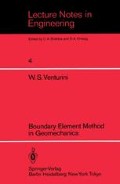Abstract
Numerical techniques for solving many problems in continuum mechanics have experienced a tremendous growth in the last twenty years due to the development of large high speed computers. In particular, geomechanical stress analysis can now be modelled within a more realistic context.
Access this chapter
Tax calculation will be finalised at checkout
Purchases are for personal use only
Preview
Unable to display preview. Download preview PDF.
Author information
Authors and Affiliations
Rights and permissions
Copyright information
© 1983 Springer-Verlag Berlin Heidelberg
About this chapter
Cite this chapter
Venturini, W.S. (1983). Introduction. In: Boundary Element Method in Geomechanics. Lecture Notes in Engineering, vol 4. Springer, Berlin, Heidelberg. https://doi.org/10.1007/978-3-642-82099-1_1
Download citation
DOI: https://doi.org/10.1007/978-3-642-82099-1_1
Publisher Name: Springer, Berlin, Heidelberg
Print ISBN: 978-3-540-12653-9
Online ISBN: 978-3-642-82099-1
eBook Packages: Springer Book Archive

